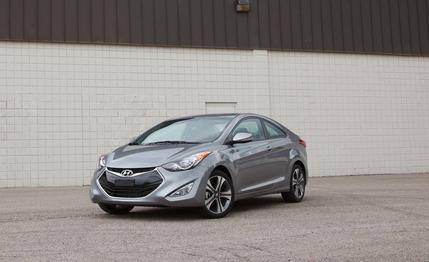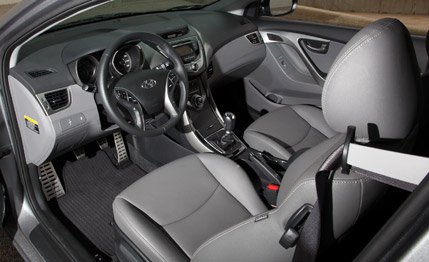
 Instrumented Test
Instrumented Test


The coupe designation has been blurred by the marketing minions, but we ordinarily understand it to describe a car with two doors and a formal trunk. Beyond that, we tend to perceive coupes as sexier than their sedan equivalents, with a suggestion of more performance.
The sexier part of this perception is true of the 2013 Hyundai Elantra coupe. Its four-door sibling is already one of the more-eye-catching members of the compact crowd, and subtracting a set of doors adds a little more visual zing to the package. But if you expect a corresponding increase in dynamic zing, you’re likely to be disappointed.
Tale of the Tape
Subtracting a set of doors can be an oversimplification, but not in this case. The wheelbase, width, and height dimensions of the two- and four-door versions of the Elantra are essentially identical. The only distinction is in overall length. At 178.7 inches, the coupe is 0.4 inch longer, which might add a little subliminal drama to its wedgy good looks.


For the coupe’s front passengers, leg and shoulder room remain the same; head and hip room drop slightly. For rear-seat passengers, headroom is the same, at 37.1 inches, but legroom actually increases by 0.2 inch in the two-door, and hiproom is up by 0.4 inch (Hyundai says this is due to the absence of the rear door and normal protuberances such as door handles). The sedan’s only real advantage here is its easier rear-seat access. There’s a slight distinction at the scales, too. The coupe’s curb weights run a few pounds heavier, according to Hyundai, but this is academic.
Hyundai points out that the Elantra coupe has advantages in passenger and cargo volume versus its two main development targets, the Honda Civic coupe and the Kia Forte Koup, as well as mid-size coupes such as the Honda Accord and Nissan Altima. (As an aside, it’s interesting to note that one of the Elantra’s targets is produced by Hyundai’s Kia sibling.) The Scion tC, a car conspicuous in its absence from Hyundai’s volume discussions, has slightly less interior room, but its hatch can swallow three times the cargo of the Elantra’s trunk.
Like the Elantra sedan, the base coupe comes well equipped. For example, standard features on the $18,220 GS include air conditioning, heated front seats, a tilting-and-telescoping steering column, fog lights, 16-inch aluminum wheels, Bluetooth phone connectivity, remote keyless entry, and a six-speaker AM/FM/CD/MP3 audio system with iPod and USB input jacks. The sportier SE ($20,520) adds firmer suspension tuning, 17-inch wheels, a power sunroof, leather seats, a leather-wrapped steering wheel and shift knob, aluminum-clad pedals, and a rear decklid spoiler.